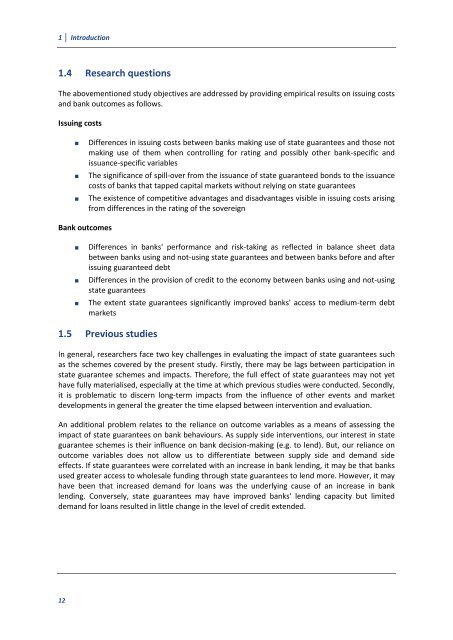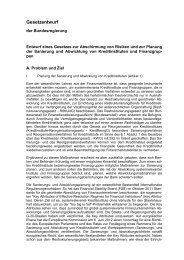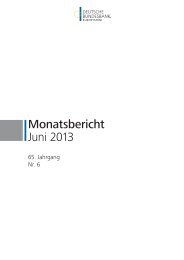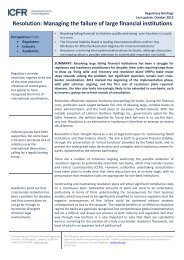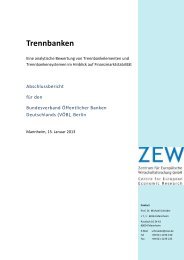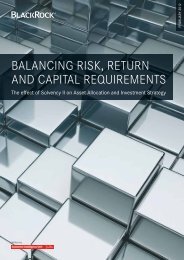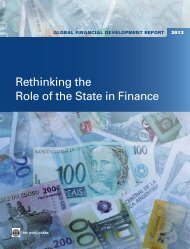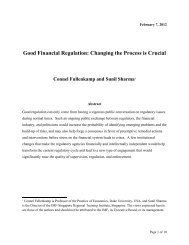3 Issuing costs of state guaranteed bonds - Financial Risk and ...
3 Issuing costs of state guaranteed bonds - Financial Risk and ...
3 Issuing costs of state guaranteed bonds - Financial Risk and ...
You also want an ePaper? Increase the reach of your titles
YUMPU automatically turns print PDFs into web optimized ePapers that Google loves.
1 Introduction<br />
1.4 Research questions<br />
The abovementioned study objectives are addressed by providing empirical results on issuing <strong>costs</strong><br />
<strong>and</strong> bank outcomes as follows.<br />
<strong>Issuing</strong> <strong>costs</strong><br />
12<br />
Differences in issuing <strong>costs</strong> between banks making use <strong>of</strong> <strong>state</strong> guarantees <strong>and</strong> those not<br />
making use <strong>of</strong> them when controlling for rating <strong>and</strong> possibly other bank-specific <strong>and</strong><br />
issuance-specific variables<br />
The significance <strong>of</strong> spill-over from the issuance <strong>of</strong> <strong>state</strong> <strong>guaranteed</strong> <strong>bonds</strong> to the issuance<br />
<strong>costs</strong> <strong>of</strong> banks that tapped capital markets without relying on <strong>state</strong> guarantees<br />
The existence <strong>of</strong> competitive advantages <strong>and</strong> disadvantages visible in issuing <strong>costs</strong> arising<br />
from differences in the rating <strong>of</strong> the sovereign<br />
Bank outcomes<br />
Differences in banks' performance <strong>and</strong> risk-taking as reflected in balance sheet data<br />
between banks using <strong>and</strong> not-using <strong>state</strong> guarantees <strong>and</strong> between banks before <strong>and</strong> after<br />
issuing <strong>guaranteed</strong> debt<br />
Differences in the provision <strong>of</strong> credit to the economy between banks using <strong>and</strong> not-using<br />
<strong>state</strong> guarantees<br />
The extent <strong>state</strong> guarantees significantly improved banks' access to medium-term debt<br />
markets<br />
1.5 Previous studies<br />
In general, researchers face two key challenges in evaluating the impact <strong>of</strong> <strong>state</strong> guarantees such<br />
as the schemes covered by the present study. Firstly, there may be lags between participation in<br />
<strong>state</strong> guarantee schemes <strong>and</strong> impacts. Therefore, the full effect <strong>of</strong> <strong>state</strong> guarantees may not yet<br />
have fully materialised, especially at the time at which previous studies were conducted. Secondly,<br />
it is problematic to discern long-term impacts from the influence <strong>of</strong> other events <strong>and</strong> market<br />
developments in general the greater the time elapsed between intervention <strong>and</strong> evaluation.<br />
An additional problem relates to the reliance on outcome variables as a means <strong>of</strong> assessing the<br />
impact <strong>of</strong> <strong>state</strong> guarantees on bank behaviours. As supply side interventions, our interest in <strong>state</strong><br />
guarantee schemes is their influence on bank decision-making (e.g. to lend). But, our reliance on<br />
outcome variables does not allow us to differentiate between supply side <strong>and</strong> dem<strong>and</strong> side<br />
effects. If <strong>state</strong> guarantees were correlated with an increase in bank lending, it may be that banks<br />
used greater access to wholesale funding through <strong>state</strong> guarantees to lend more. However, it may<br />
have been that increased dem<strong>and</strong> for loans was the underlying cause <strong>of</strong> an increase in bank<br />
lending. Conversely, <strong>state</strong> guarantees may have improved banks' lending capacity but limited<br />
dem<strong>and</strong> for loans resulted in little change in the level <strong>of</strong> credit extended.


